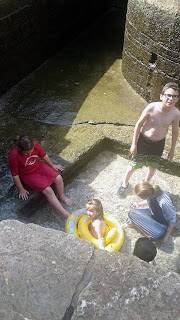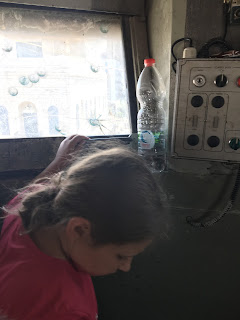Resigned to our fate we headed to the next spot, which was actually a surprise for us that was not far past Eretz Bereishith. We were heading into the Judean desert, and as we continued further south, the temperature was steadily rising. The signs indicated we were heading toward the Dead Sea and then, suddenly, Gershon instructed David to pull over to the side of the road, which was actually a small parking lot. From where we sat there appeared to be nothing particularly to do over here. Gershon assured us that this was going to be worth it and told everyone to get into their swim gear. Noticing that we were surrounded by tall mountains and steep valleys and that Gershon was pointing to a narrow, rocky path , my mother opted to stay in the car, perhaps fearful of another surprise hike.
The path to our destination only started off narrow and rocky. Shortly after, it became a paved road angled sharply downward. Gershon was 100% correct on how great this would be, as this proved to be our most popular recreational stop. At the bottom of the hill was a spring called Ayin Mavoah. The water of the spring was harnessed into a prepared swimming area deeply set into the ground. The unique feature of Ayin Mavoah was that it was a spring situated over underground caverns that worked as vacuums, sucking the water inward and pushing it outward again. In this way, the swimming hole emptied and filled with refreshing but very cold water every 20 minutes or so. It was very cool to swim in the deep water and slowly discover that one’s feet could now touch the ground until one was standing on dry earth, and then, after waiting a torturous few minutes, watching the water rush back in and feel oneself slowly float up. It was delightful in the heat, and it grew steadily more crowed as the morning wore on.
After the swim, we trekked up the long steep road and reunited with Grandma, who had waited patiently for us. Gershon proposed that we stop at Eretz Bereishith, which was on our way to our next stop, and try our luck at there being an opportunity to ride the camels. We were successful! Now, if we had made it at our scheduled time we would have ridden the camels down the descending path to a re-enactment area where one is meant to feel as if they are visiting the tent of Abraham and then, after prepared activities, return along a narrow trail once again on camelback. Because we were slipping-in between appointments and several more camels were needed below, we received a one way trip (and not a few of us were QUITE ok with walking back up anyway!).
The camels were sitting beside the building ready for “boarding.” Mom immediately opted for skipping the ride atop the tall dromedary and when David tried to bring Asher with him, the little guy flipped out. “No camel me!” he yelled, and so he stayed with Grandma. I paired with Yaakov, and we both firmly believe that the saddle was just slightly off-center. I felt like I was tilting sideways the whole ride to stay balanced. Riding camels is a must-do for touring Israel, and I think we all fulfilled that requirement without a passion to do so again.
Out next stop was Kever Rochel, the Tomb of Rachel, which is located in Bethlehem. The Tomb is an isolated compound in the territory of the Palestinian Authority.
I have to be honest and note that I, personally, do not even remember how we got to Bethlehem. Many of the nights of the trip I had been up late working and the car lulled me to sleep. One moment we were in a familiar neighborhood in Jerusalem near the Old City and the next, what felt to me like a five second doze, we were in a similar neighborhood in Bethlehem. It was considerably disorientating.
Once upon a time, even when I came as a child, people who came to Kever Rochel saw this:
Alas, since the intifada and the transfer of Bethlehem to control of the Palestinian Authority, that humbly beautiful vision is lost behind massive walls topped with barbed wire and watchtowers. The parking lot was full as Jews come here in a steady stream to pray.
According to Jewish tradition, God was particularly open to the prayers of Rachel. In the merit of her having given her sister the secret codes that allowed her to marry Jacob (Genesis 29). For this reason, and perhaps because it has truly one of the longest histories as a Jewish holy site, it is considered a place where one has a more open, so to speak, line to God. Also, this site is very significant to mothers and to women who wish to be mothers because Rachel suffered to have children.
There isn't much to describe about being at the synagogue itself. We all did our own prayers and then met outside. Timing wise, a Mincha (afternoon service) minyan was about. To start. Since the girls and I had davened Mincha already, we waited outside with Yaakov and Asher. It was hot and one child became increasingly grumpy. When the guys came out and Gershon announced that we had a really cool opportunity to meet and see the small settlement attached to the Kever Rochel enclave, this child and I went back to the van for an emotional cool down. I hope I can get someone to write about it.
We grabbed a lunch of pizza and falafel in Gush Etzion and headed for Hebron and Maarat Hamachpela, the Cave of the Patriarchs, and truly one of the holiest sites in Jewish tradition.
I don’t know what I expected of the area we drove through between Bethlehem and Hebron, but the drive was not that much different than between any other towns we moved through in Israel.
Hebron is a town known for having a “challenging situation” between Jews and Arabs. The primary Jewish settlement, which is Kiryat Arba. Gershon had many friends an connections in the area, this being a particularly important location for people involved in active settlement, and he would have been delighted to give us a proper tour, but our goal in coming to Hebron was the “Tomb of the Patriarchs.”
This is the site which, according to Jewish tradition, Abraham purchased to bury Sarah because he knew that it was the cave in which Adam and Eve were buried. Abraham was also buried there, as were Isaac and Rebecca and Jacob and Leah (and, according to legend, the head of Esau, but that’s a whole story unto itself). The incredible building that was built over this site was erected by Herod during the Roman era and has remained in use throughout the different rulers of the land. It has served as a synagogue, a church, a mosque.
Here’s a concise explanation for JewishVirtualLibrary.org:
This uniquely impressive building is the only one that stands intact and still fulfills its original function after thousands of years. Foreign conquerors and invaders used the site for their own purposes, depending on their religious orientation: the Byzantines and Crusaders transformed it into a church and the Muslims rendered it a mosque. About 700 years ago, the Muslim Mamelukes conquered Hebron, declared the structure a mosque and forbade entry to Jews, who were not allowed past the seventh step on a staircase outside the building.
Upon the liberation of Hebron in 1967, the Chief Rabbi of the Israel Defense Forces, the late Major-General Rabbi Shlomo Goren, was the first Jew to enter the Cave of Machpelah. Since then, Jews have been struggling to regain their prayer rights at the site, still run by the Muslim Waqf (Religious Trust) that took control during the Arab conquest. Many restrictions are imposed on Jewish prayers and customs at the Tomb of the Patriarchs despite the site's significance, primacy and sanctity in Jewish heritage and history.
I had been to Maarat Hamachpelah before, but it had been many, many years ago. I was very excited to have this opportunity to come here again. As we entered, we passed a family that was all dressed up. They were there to celebrate a bris milah, a circumcision.
Even before we entered, we were touring. I was fascinated by the place Gershon showed us that was the “seventh step.” As mentioned in the description above, when the Muslim’s had complete control of the site, Jews were not allowed past the outside staircase’s seventh step and many Jews still pray in that same location.
Maarat Hamachpela is divided into different chapels, for lack of a better English word, that are marked as the tombs of the Patriarchs. And while they appear to have large burial caskets within the alcoves, the actual remains of the patriarchs and matriarchs would be far below. Of course, having two boys with patriarchal names, I couldn’t resist taking pictures of them at their respective chapels.
 |
| The tomb of the Matriarch Leah, not sure why I don't have Leah's photo here like I had the boys. |
More seriously, this is one of the most ancient sites in the heritage of our people. I definitely felt a profound sense of awe here and I made it a specific point to use my time there to daven (pray) for the people in my life and people I new had specific needs such as health, children, finding a spouse and parnassa.
As we left the complex, we stopped to take pictures with some lovely soldiers...
I think that everyone in our party gained something positive from this stop. However, the children were getting restless. At Gershon’s recommendation we returned to Gush Etzion and went to a park that was across from where we had eaten lunch. The park, which was dedicated to the memory of the three youths who had been kidnapped and murdered in 2014, contained several play areas appropriate for different ages, including a zip line. There was also an area for camping. Oddly enough, there was also a donkey wandering around...still not sure why.




















No comments:
Post a Comment